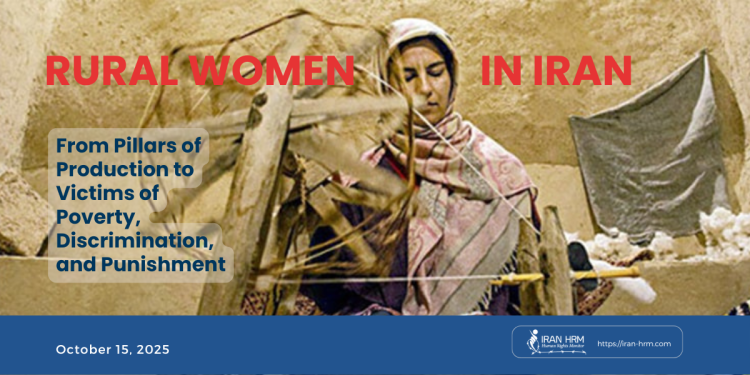Human Rights Analytical Report – On the Occasion of the International Day of Rural Women (15 October 2025)
Introduction
International Day of Rural Women highlights the situation of millions of Iranian women whose shoulders form the invisible pillars of the national economy but who themselves are trapped in poverty, discrimination, and injustice. Under the ruling regime in Iran, rural and nomadic women—more than 11 million individuals—constitute a significant portion of the country’s agricultural, livestock, and handicraft production. Despite their crucial role, they remain deprived of the most basic human and economic rights. Discriminatory laws, patriarchal traditions, and regional inequalities have turned these women into one of the most vulnerable groups in Iranian society.
Women Without Rights at the Heart of Production
According to official statistics, 59% of rural women actively work in agriculture and livestock, contributing to over 80% of agricultural processing and 70% of traditional poultry and livestock production. However, only 6% of farmlands are registered in women’s names. They are mostly classified as “unpaid family labor,” with no access to insurance, pensions, or bank credit. Article 948 of the Civil Code denies women real inheritance of land, granting them only its cash value. This legal deprivation separates rural women from their primary means of independence and leaves them economically powerless.
Multidimensional Poverty and Everyday Discrimination
The deprivation of rural women is not merely financial but a web of educational, health, and infrastructural poverty that surrounds their lives. The literacy rate among rural women stands at 73%—15 percentage points lower than that of urban women. Only 43.4% of rural households have access to safe drinking water, and more than 10,000 villages still lack access to high-speed internet. These figures show that development in Iran has not only failed to reach rural women but has further marginalized them. The absence of basic infrastructure leaves women burdened with housework, farming, animal care, and water collection all at once.
In provinces like Lorestan, Sistan and Baluchestan, and Khuzestan, women work from before sunrise until midnight. One woman from Aligudarz said: “Our labor is heavier than men’s, but no one notices until a woman dies or gets sick and everything falls apart.”
Life Under Violence and Forced Marriage
In many deprived areas, rural girls are married off before the age of 15. The lack of nearby schools, family poverty, and patriarchal customs prevent them from accessing education and trap them in cycles of early pregnancy, domestic violence, and permanent poverty. These forced marriages sometimes lead to tragedy—young girls who suffer years of abuse eventually act in self-defense and end up sentenced to death under qisas laws.
From Poverty to Prison and Execution
Human rights reports indicate a direct link between rural poverty, gender discrimination, and harsh criminal punishments. As of October 2025, at least 40 women have been executed in Iran—the highest number in the past two decades. Most of these women came from poor, uneducated families in rural or border regions. Their charges fall mainly into two categories: 1) intentional murder (qisas) and 2) drug-related crimes. In qisas cases, many of the women had endured prolonged domestic violence and acted in self-defense. In drug-related cases, economic desperation and lack of job opportunities drove them into smuggling networks. These executions are not the result of crime alone but of poverty and structural inequality. Many women sentenced to death under qisas cannot afford blood money or gain the victim’s family’s consent, leading to secret executions.
Stories from the Margins of Survival
In Sistan and Baluchestan, women and girls walk long distances daily to fetch water, carrying heavy containers in 50°C heat—causing spinal injuries, miscarriages, and chronic fatigue. In recent years, several young girls have drowned in natural water pits known as hootags while trying to collect water. In Khuzestan, women queue for hours to fill a single jug of clean water. In Lorestan and Kohgiluyeh, female weavers and livestock keepers, lacking any governmental support, sell their products to intermediaries at minimal prices. A Baluchi woman stated: “We work all our lives—either on others’ land or just to survive. But our names are written nowhere.”
Baluchi, Kurdish, and Nomadic Women: Triple Victims of Poverty, Gender, and Ethnicity
Women from ethnic minorities suffer the most under overlapping layers of poverty and discrimination. Statistics show that a significant share of executed women are Baluchi and Kurdish—residents of provinces with the highest rates of poverty and unemployment. In these regions, economic deprivation, gender-based discrimination, and ethnic marginalization intersect. Baluchi women, deprived of land and employment, often face unfair drug-related trials without legal counsel or adequate translation.
Control and Silence Instead of Justice
At first glance, the proportion of female prisoners in poor provinces seems low—only 1.1% in Sistan and Baluchestan compared to a national average of 3.8%. However, this decline does not reflect improvement; it is the result of strict tribal and social control over women. In these closed communities, women are largely confined to domestic spaces. When conflict arises, their fate is not imprisonment but often death—by execution or through forced silence.
Legal Discrimination from Home to Court
In Iran, the law itself sustains discrimination rather than prevents it. Family, inheritance, and marriage laws strip women of financial independence and decision-making power. In drug-related cases, courts make no distinction between professional traffickers and women pushed into crime by poverty. The same regime that denies women access to education and employment punishes them for their poverty—turning gender discrimination into a legal and structural reality.
International Call to Action
The situation of rural women in Iran is a multidimensional human crisis. Poverty, discrimination, and punishment are interwoven, and the ruling regime in Iran is the main cause. The international community—the United Nations, the European Union, and global women’s rights organizations—must use every diplomatic, legal, and humanitarian mechanism to stop the execution of women, abolish discriminatory laws, and support targeted development and protection programs for women in rural and nomadic regions.
Conclusion
Rural women in Iran are the driving force behind national production but live in a system that binds them in chains of poverty and discrimination—from labor to death. From the fields to prisons, from the farms to the gallows, a single line of gender inequality defines their lives. A just future for Iran will only be possible when the voices of these women are heard, and justice becomes a global commitment to end systematic discrimination against them. While international human rights organizations have repeatedly condemned the rise in executions and ethnic discrimination, the plight of Iran’s rural women—especially Baluchi, Kurdish, and nomadic women—remains largely overlooked by the world.







